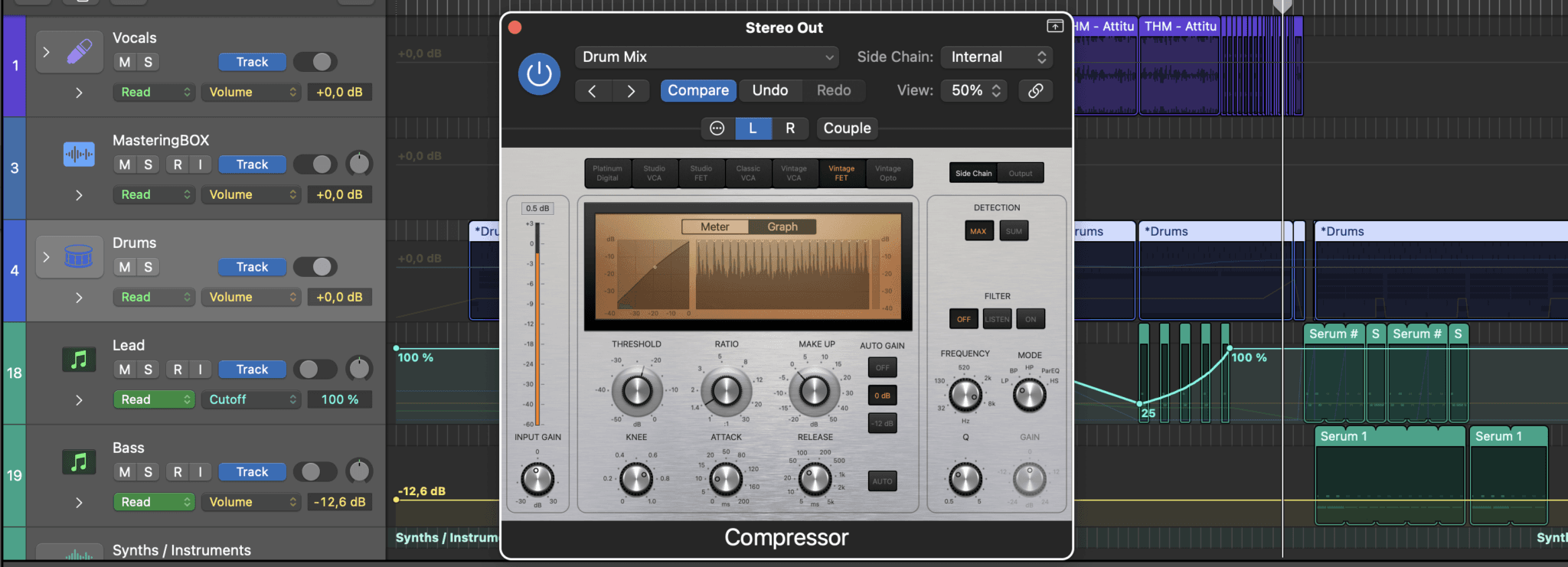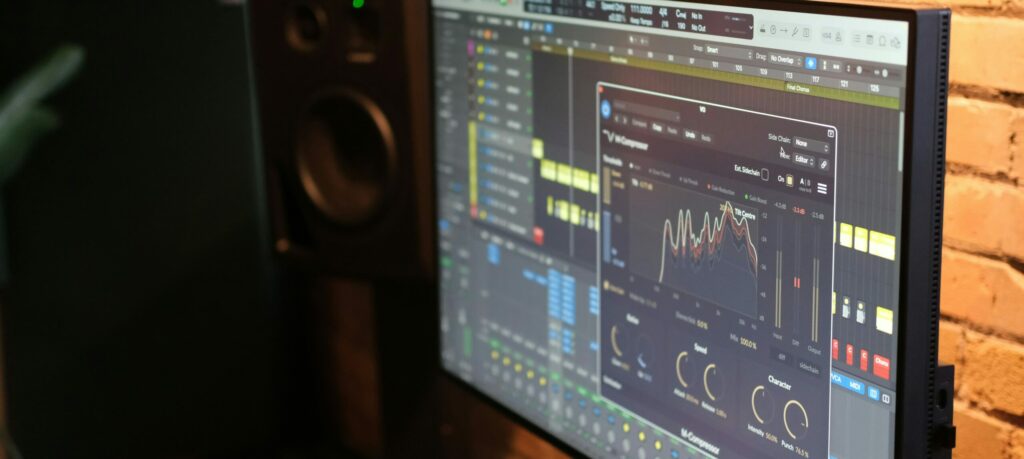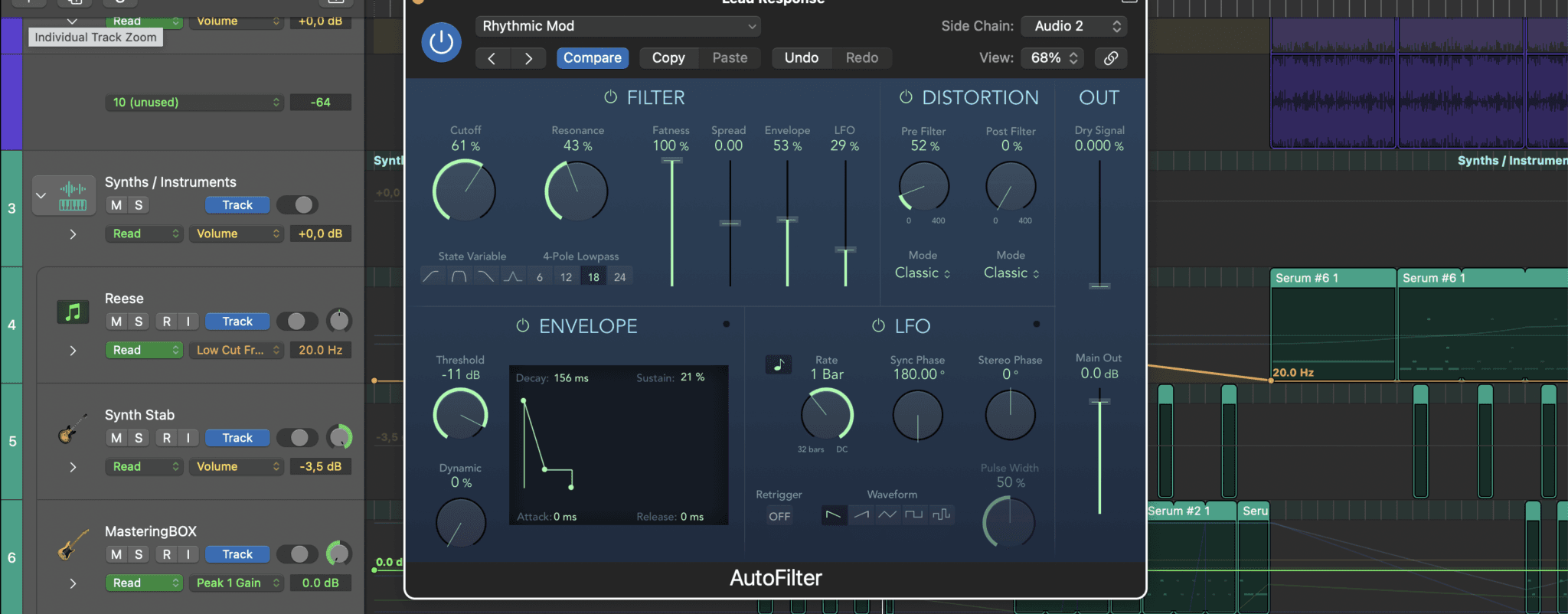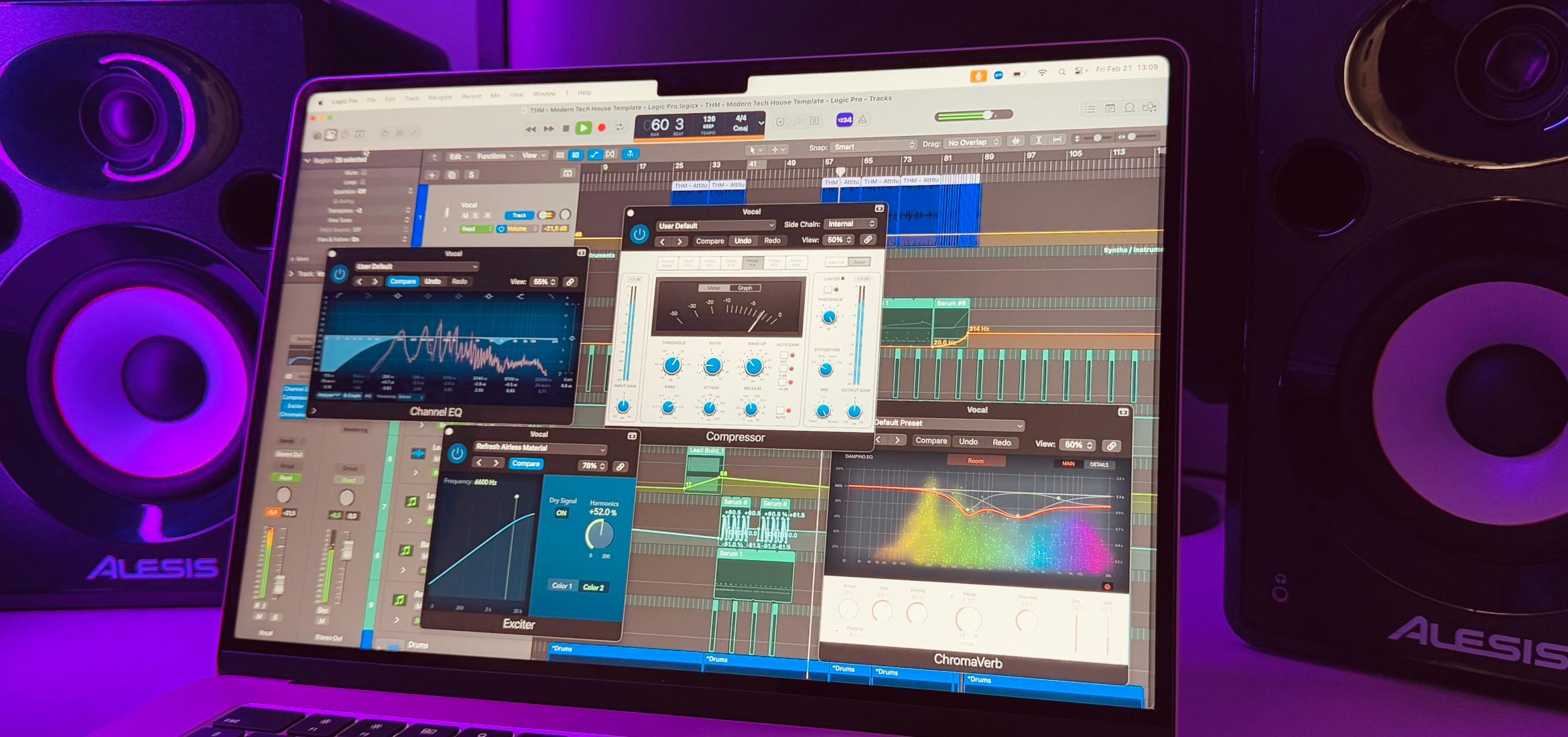Sidechain (side-chain) techniques can enhance not only the dynamics and clarity of your mix but also add an element of creativity that can differentiate your sound. By experimenting with various sidechaining methods, such as using different audio sources or adjusting the threshold and ratio settings, you can discover unique textures and rhythmic patterns that elevate your music.
Whether you’re aiming for subtlety or dramatic effects, mastering sidechain can open up a world of possibilities in your audio production journey. In this article, our goal is to explain what sidechain is and how you can use it in different ways.
Table of Contents
- What is Sidechain?
- Sidechain Compression Techniques
- Sidechain Equalization Techniques
- Sidechain Reverb and Delay Techniques
- Sidechain Distortion and Saturation Techniques
- Sidechain Modulation Techniques
- Applications Beyond Dance Music
- Experimentation is Key
- TL;DR
What is Sidechain?
In audio production, the term sidechain broadly refers to a technique where the processing of an audio signal is influenced by a different audio signal. Sidechain compression is one of the most common applications of this technique, but it is not the only type of sidechain processing. Sidechain works by sending a signal from one channel to another to be used as an input trigger. However, unlike a normal send, a sidechain does not transfer sound.
Often considered a more advanced technique, it has a multitude of uses but is misunderstood by many. There are plenty of great ways to utilize sidechaining in your day-to-day audio work to improve workflow, ease mixing, and create powerful effects.
Sidechain Compression Techniques
The most well-known and often-used sidechaining technique, sidechain compression, appears heavily within the urban and electronic music scenes. Have you ever noticed that huge pumping sound on the kick of a dance track? That’s sidechain compression. The basis for this technique is to use the signal of one sound as a trigger to compress (essentially duck) another sound. This is common in dance music, where we use the kick drum to duck the bass line and synth sounds. This offers a huge, rhythmic pumping sound and helps to drive the track.

Some History of Sidechain Compression
The concept of sidechain compression dates back to the early days of audio production, where engineers sought innovative ways to manage overlapping sounds in dense mixes. Originally popularized in the late 1970s and 1980s, it emerged as a staple technique in various genres, particularly in pop and electronic music. As technology evolved, so did the applications of sidechain compression, leading to its widespread adoption in modern music production. Today, producers leverage sidechain techniques not only for rhythmic effects but also for enhancing overall mix clarity, showcasing its versatility and importance in the audio engineering toolkit.
Practical Uses of Sidechain Compression
Sidechain compression is an essential tool in modern audio production, with applications that range from practical mix-cleaning to dynamic effects. By responding to one sound with the behavior of another, it offers endless opportunities for sculpting your mix. Here’s a blend of classic and innovative ways to use this technique:
Punching Up the Kick Drum:
When the kick drum fights for space with the bassline, sidechain compression can resolve the conflict. Setting the kick as the trigger for the compressor on the bass ensures that every kick hit creates a momentary dip in the bass. This not only brings clarity to the low end but also adds a rhythmic energy that keeps the groove tight and impactful.
Creating Movement in Synth Layers:
Layering synthesizers can lead to lush but overwhelming textures. Sidechaining pads or ambient synths to a lead line allows the pads to breathe, fading in and out dynamically as the lead plays. This technique prevents harmonic competition while adding a sense of ebb and flow.
Controlling Overhead Drum Bleed:
Drum overheads often pick up excessive snare energy, overpowering the rest of the kit. By placing a sidechained compressor on the overhead track and using the snare close mic as the trigger, you can tame these peaks and restore balance to the drum mix.
Highlighting Lead Vocals:
Bright, rhythm-heavy guitars, pianos, or other mid-frequency instruments can mask a lead vocal’s clarity. Use a dynamic EQ or multiband compressor with sidechaining to subtly attenuate the instrument’s frequencies where the vocal shines. This allows the vocal to remain prominent without sacrificing the energy of the instrument.
Adding Groove to Percussion Tracks:
Static percussion loops can be brought to life with sidechain compression. Triggering subtle dips in a shaker, tambourine, or hi-hat using the rhythm of a kick or snare creates interplay between elements, making the loop feel more dynamic and engaging.

Iconic Gated Reverb for Drums:
To channel vintage ‘80s vibes, pair a reverb effect on a snare with a sidechained gate. The gate opens when the snare hits, creating a dramatic burst of reverb that cuts off sharply. This effect adds a larger-than-life character to your drum mix.
Balancing Cinematic Soundscapes:
In film scoring, ambient textures like drones or orchestral swells can overpower dialogue or key sound effects. Sidechain compression can dynamically reduce these elements when dialogue enters, preserving clarity while maintaining an immersive atmosphere.
Defining Drops in EDM and Pop Music:
The rhythmic “pumping” effect, where kick drum hits duck other elements like bass, pads, or synths, is a staple in electronic music. Sidechain compression here not only keeps the low end clear but also adds the dynamic motion that defines genres like house, future bass, and pop.
Adding Emotional Swells to Pads:
To create evolving textures, sidechain long pads or string sections to a vocal or piano line. The pad will fade out during the lead and swell back in during pauses, creating a breathing, emotive effect that enhances the arrangement.
Taming Bleed in Drum Mics:
For multi-mic drum setups, bleed can clutter the mix. For instance, a “Kick Out” mic picking up other kit elements can be cleaned up with a gate sidechained to the “Kick In” mic. This ensures the gate opens only when the kick plays, isolating it from unwanted noise.
Enhancing Live Solo Performances:
In live settings, sidechain compression can ensure a soloist shines. Ducking rhythm sections or accompaniment tracks based on the solo instrument ensures the performance remains expressive and central in the mix.
These are just a few sidechaining compression techniques to consider. Don’t hesitate to experiment and tap into your creativity to uncover additional uses for sidechain compression. Allow your distinctive style to emerge as you incorporate these techniques into your production process.
Sidechain Equalization Techniques
Sidechain equalization is a powerful technique that not only enhances clarity in your mix but also allows for creative sound design. By strategically ducking certain frequencies in one audio signal based on another, you can create space for key elements to shine through. This method can be particularly effective in complex arrangements where multiple instruments vie for attention. Additionally, experimenting with sidechain equalization can lead to innovative textures and dynamic interactions between sounds, making your mix more engaging and polished. Embrace this technique to elevate your production and achieve a professional sound.

Understanding Frequency Masking
Frequency masking occurs when two sounds occupy similar frequency ranges and one sound obscures the other. This phenomenon can lead to a lack of clarity in the mix, making it difficult for listeners to discern individual elements.
Frequency masking is often a huge problem in amateur mixes. The build and subsequent clash in harsh frequency ranges can make a great song sound awful. Piercing highs, muddy lows, and bloated mids are things we never want to hear. It is particularly evident in dense arrangements where multiple instruments compete for attention. By understanding how frequency masking works, sound engineers can use specific techniques, like sidechain equalization, to mitigate its effects.
The Importance of Sidechain Input
These days, most parametric EQs will offer a sidechain input. If yours doesn’t, I recommend checking out Fabfilter and their line of EQs. By sidechaining one signal into the EQ of another, we can visually see the areas where two sounds clash. This visual feedback is invaluable; it allows us to pinpoint problematic frequencies and make precise adjustments.
Practical Applications of Sidechain Equalization
A great example of this would be the contention between a lead guitar and a vocal. Both working in very similar frequency ranges, the two can often bury each other. By utilizing sidechain equalization to tackle this frequency masking, we can duck some of the important vocal frequencies from the guitar line. This ensures clarity and power.
Another common scenario is when a kick drum and bass guitar are competing in the lower frequencies. In such cases, using sidechained EQ can help to carve out a space for the kick drum by reducing the bass frequencies at specific moments, allowing each element to be heard distinctly. This technique not only improves the overall balance of the mix but also enhances the rhythmic drive of the track.
Best Practices for Sidechain Equalization
- Identify Clashing Frequencies: Start by listening critically to the mixed elements. Use a frequency analyzer if necessary to identify where the overlaps occur.
- Adjust the Sidechain Settings: Set the sidechain input on your EQ to the source that you want to create space for. Fine-tune the threshold and ratio to control how much ducking occurs.
- Use Gentle Cuts: When applying EQ cuts, be gentle. Overly aggressive cuts can make the sound unnatural. Aim for a smooth reduction in the masked frequencies.
- Check in Context: Always make adjustments while listening to the entire mix. Soloing individual tracks can sometimes lead to misleading impressions of what sounds good.
By mastering sidechain equalization techniques, you can greatly improve the clarity and impact of your mixes, ensuring that every element has its own space while maintaining a cohesive overall sound.
Sidechain Reverb and Delay Techniques
This technique is predominantly stylistic but can offer some brilliant and unusual effects. By sidechaining a signal into its own effect send and using a compressor, we can not only improve clarity but also create huge effect swells in the transitional sections of our music.
Let’s say you’ve got a lead vocal that you have fed into a delay send in order to add some color and texture to your track. However, sometimes these delays can get a little cluttered, and the words become hard to hear. You like the amount of effect you’ve used, and you just can’t seem to balance the two. By sidechaining the vocal signal to its own delay send and keying it into a compressor at the end of the effects chain, you can use the vocal to suppress its own effect send, thus ducking the delays when the vocal is playing. This will improve clarity in the mix as well as allow the delays to fill up space within the song.
Equally, by setting the compressor to very high ducking (10-20dB), you can create wonderful explosive swells from delay and reverb at the end of vocal lines. This is a very abstract technique but certainly one that could set you apart from the crowd.
Sidechain Distortion and Saturation Techniques
Some distortion and saturation plugins use a sidechain input to determine when and how the effect is applied. For instance, a common application is saturating a signal more when a specific transient sound is present. This technique allows for greater control over the dynamics of the mix, ensuring that the saturation effect enhances the desired elements without overwhelming others.
How Sidechain Distortion Works
Sidechain distortion leverages the strengths of a primary audio source while allowing secondary signals to dictate the processing. When the sidechain input detects a transient, it triggers the saturation effect, resulting in a more pronounced impact during key moments in the track. This approach can be particularly useful for drums, where the kick or snare can activate the saturation, adding warmth and character to the overall sound without muddying the mix.
Creative Applications
Beyond traditional uses, sidechain distortion can have creative applications when selecting unconventional sidechain sources. This can include melodic elements or even environmental sounds, which can create unique textures and dynamics. For example, sidechaining a vocal track to distort a bassline can lead to intriguing rhythmic interactions, making the mix feel more alive and engaging.
Tips for Effective Sidechain Distortion
- Choose the Right Source: Select a sidechain input that complements the main signal. Percussive elements often work well, but experimenting with different sources can yield interesting results.
- Adjust Threshold and Ratio: Fine-tune the threshold and ratio settings to ensure the sidechain effect enhances rather than dominates the sound. Subtle adjustments can lead to a more polished outcome.
- Listen in Context: Always evaluate the effect in the context of the full mix. What sounds good in isolation may not translate well when other elements are present.
- Automate Parameters: Consider automating the distortion amount or the sidechain sensitivity for dynamic changes throughout the track. This can create an evolving sound that keeps the listener engaged.

By incorporating sidechain distortion and saturation thoughtfully, you can elevate your mixes, giving them depth and character while retaining clarity and punch.
Sidechain Modulation Techniques
Sidechain signals can be used in modulation effects like tremolo, panning, or filters. These creative applications not only enhance the overall sound design but also help create a more dynamic and engaging listening experience.
One of the most common uses of sidechain modulation is in filter effects. For instance, a filter’s cutoff frequency can be dynamically controlled by a kick drum, creating a rhythmic “wobble.” This technique is especially popular in genres like EDM, where the pulsing rhythm generated by the kick can drive the energy of the track. By automating the filter to open and close in sync with the kick, producers can create movement and interest in otherwise static sounds.
Additional Applications of Sidechain Modulation
Beyond filters, sidechain modulation can breathe life into other effects. For example, tremolo can be manipulated through a sidechain input, allowing the modulation depth to be triggered by a different audio source, such as a snare hit or synth stab. This results in a unique rhythmic effect that adds texture and complexity to the sound.
Panning is another area where sidechain modulation shines. By applying a sidechain signal to the pan position of an audio track, you can create a stereo image that feels alive and constantly shifting. For example, if a vocal line is panned to the left and the sidechain input is tied to a percussion loop, the vocal can subtly shift back and forth in the stereo field, creating an immersive listening experience.
Creative Techniques and Tips
When implementing sidechain modulation, experimentation is key. Try using different audio sources as sidechain inputs to achieve unexpected results. Additionally, adjusting the attack and release settings can help fine-tune the responsiveness of the modulation to better fit the groove of the track.
Don’t be afraid to layer multiple sidechain-modulated effects together. Combining a sidechain filter with a sidechain tremolo can produce a rich, textured sound that’s both rhythmic and dynamic, enhancing the overall production.
Ultimately, sidechain modulation is a powerful technique that can elevate your music production by adding depth, movement, and excitement to your tracks.
Applications Beyond Dance Music
While sidechain compression is popularly associated with dance music, its versatility allows it to be used in various genres. For instance, in rock music, it can help vocals stand out against a wall of guitars. In pop, sidechaining can create a more polished and radio-ready sound. Exploring different applications can lead to unique textures and dynamics in your music.
Experimentation is Key
Don’t be afraid to push the boundaries of traditional sidechain techniques. Instead of just using it on the bass, experiment with vocals, synths, and even effects. By adjusting the attack and release times of your compressor, you can create rhythmic pumping effects or subtle ducking that enhances the musicality of your mix.
TL;DR
Sidechain is a wonderful tool. Contrary to popular belief, it isn’t just used for dance floor pumping, and if learned properly, it can bring incredible ease to the mixing process. Incorporating sidechain into your mixing workflow can transform your tracks and elevate your sound design. Play around, try different variations, and create something new.
About the Author

Tim Dunphy
Audio Engineer and Specialized Content WriterOver 10 years experience working in the audio business. Everything from coiling up XLRs to mastering albums. I'm a self-made man and I keep my assets in Bitcoin. What more is there to know!?
Leave a comment
Log in to comment


